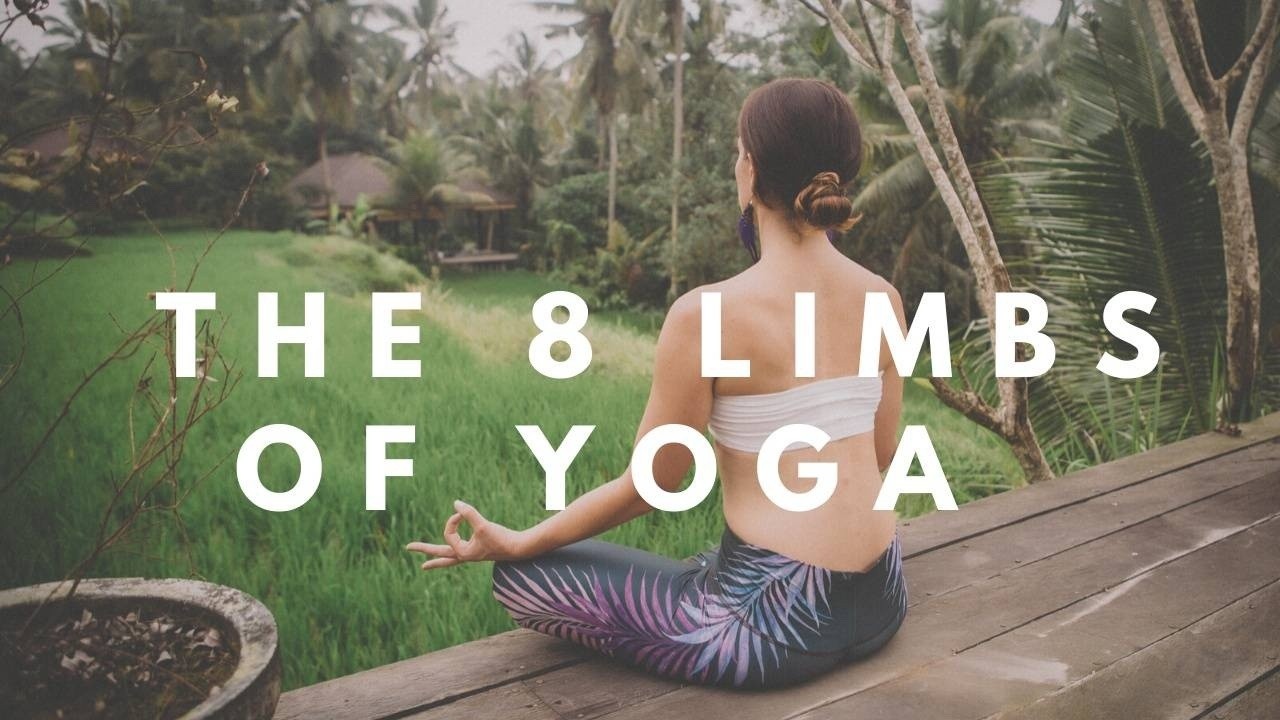Are you living and breathing your yoga ON and OFF the mat?

The 8 Limbs of Yoga
You started practicing yoga to feel better and you've possibly even mastered some crazy yoga poses... now what?
Have you ever wondered if there's more to this 6000+ year old set of life enhancing tools?
I'm here to show you there IS.


The 8 Limbs of Yoga
The Yoga Sutras
The true meaning of Yoga is the union of body, mind, soul, and spirit.
According to practice, we often suffer because of not knowing our true Self and because of the illusion of separation of our individual consciousness from Universal Consciousness. The Yoga Sutras act as a practical guide to assist you on your journey of remembering this union.
The Yoga Sutras were transcribed by a man (and most likely many of his colleagues and students) named Patanjali, presumably from India, living somewhere between the 2nd century BCE and the 5th century CE, and act as a practical guide to assist you on your journey of remembering the ultimate union.
The Yoga Sutras contain 196 verses, which discuss the aim of yoga, the development of the processes which involves the ‘8 Limbs of Yoga’ and finally, how you strive for liberation and self-realization which is the 8th limb of yoga also called Samadhi in Sanskrit.
According to the Sutras, beginning the pursuit of self-realization is the most significant step in life – as they make us aware of our pitfalls and how to overcome them.
The 8 Limbs of Yoga
Building off of the Yoga Sutras, most modern yogis focus on the 31 verses that describe the 8 Limbs of Yoga - an eight-fold path or guide on how to live in order to advance along a spiritual path towards enlightenment.
The 8 Limbs of Yoga:
1. YAMAS/ External Moral Disciplines
2. NIYAMAS/ Internal Observances
4. PRANAYAMA/ Breathing Techniques
5. PRATYAHARA / Sensory Withdrawal
8. SAMADHI/ Self-Realization & Enlightenment
1. The Yamas
Nonviolence (ahimsa), truthfulness (satya), nonstealing (asteya), nonexcess (brahmacharya), and nonattachment with the senses (aparigraha) are the five yamas, or codes of self-regulation or restraint, and are the first of the eight steps of Yoga ~ ahimsa satya asteya brahmacharya aparigraha yama ~ The Yoga Sutras of Patanjali 2.29-2.31
"The most important human endeavor is driving for morality in our actions. Our inner balance and even our very existence depend on it. Only morality in our actions can give beauty and dignity to life" ~ Albert Einstein
This first limb refers to practices that are primarily concerned with the external world around us, and our interaction with it.
While the practice of yoga can increase physical strength and flexibility and aid in calming the mind, what’s the point if we’re still rigid, weak and stressed-out in day-to-day life?
The Yamas are five concepts that can be observed in our bodies, senses, actions, words and thoughts. They help us to purify our nature, morals and values and form a healthier and happier relationship ourselves and with society.
2. The Niyamas
Purification (saucha), contentment (santosha), discipline (tapas), self-study (svadhyaya), surrendering (ishvara pranidhana) are the observances or practices of self-training (niyamas), and are the second rung on the ladder of Yoga ~ shaucha santosha tapah svadhyaya ishvarapranidhana niyamah ~ The Yoga Sutras of Patanjali 2.32, 2.40-2.45
"As human beings, our greatest lies not so much in being able to remake the world, but in the ability to remake ourselves." ~ Mohandas K. Gandhi
Where the Yamas focus on practices concerned with the external word… the second limb is primarily concerned with our internal world.
There are five concepts that help us maintain a positive environment internally and give us the self-discipline and inner-strength necessary to progress along our journey.
5. Ishvara Pranidhana/ Surrendering
3. Asanas
The posture for yoga meditation should be steady, stable, and comfortable ~ shira sukham asanam ~ The Yoga Sutras of Patanjali, Sutra 2.46-2.48
“My body is my temple and asanas are my prayers” ~ B.K.S. Iyengar
Asana is derived from Sanskrit meaning 'sitting down, a sitting posture, a seat.'
The word was first used in English to mean a yoga posture in 1834. Leslie Kaminoff writes in Yoga Anatomy that from one point of view, "all of asana practice can be viewed as a methodical way of freeing up the spine, limbs, so that the yogi can spend extended periods of time in a seated position for meditation.”
An asana is a body posture, originally a sitting pose for meditation, and later in hatha yoga and more modern variations adding reclining, folding, lateral movement, standing, inverting, twisting, and balancing poses.
The Yoga Sutras of Patanjali define ‘asana’ as a position that is steady and comfortable.
Therefore, if you are not steady and comfortable, you need to take a step back and think about why not. This is a perfect example of becoming in tune with your Ego.
4. Pranayama
Once that posture has been achieved, the slowing or braking of the force behind, and of unregulated movement of inhalation and exhalation is called breath control and expansion of prana (pranayama), which leads to the absence of the awareness of both, and is the fourth of the eight rungs ~ tasmin sati shvasa prashvsayoh gati vichchhedah pranayamah ~ The Yoga Sutras of Patanjali, Sutra 2.49-2.53
“The quality of our breath expresses our inner feelings.” ~ TKV Desikachar
The definition of pranayama is 'prana’ refers to the universal life force and ‘ayama’ means to regulate or lengthen.
Yoga identifies ‘prana’ as the universal life force which distinguishes the living from the dead, and flows through thousands of subtle energy channels called ‘nadis’ and energy centers called ‘chakras - also known as our energetic nervous system.
Yogi’s have observed the power of the breath to increase one’s prana and developed special breathing techniques to increase this energy, maintain health and create a calm, clear state of mind that is conducive for meditation.
5. Pratyahara
When the mental organs of senses and actions (indriyas) cease to be engaged with the corresponding objects in their mental realm, and assimilate or turn back into the mind-field from which they arose, this is called pratyahara, and is the fifth step ~ sva vishaya asamprayoge chittasya svarupe anukarah iva indriyanam pratyaharah ~ The Yoga Sutras of Patanjali - 2.54-2.55
“Pratyahara itself is termed as yoga, as it is the most important limb in yoga sadhana” - Swami Sivananda
Yoga has an outer layer, which consists of conscious living, conscious care of the body, and enhancement of vital energy. This is what the yamas, niyamas, asana, and pranayama are all about.
The yamas and niyamas build a foundation of these conscious behaviors through values like nonviolence and truthfulness and practices like cleanliness and contentment. Asana makes the body strong and flexible, and pranayama develops our vital energy, helping to calm the nervous system and eventually the brain, which is creating our thoughts, words, actions and experiences.
Yoga also has an inner dimension—meditation or the development of higher consciousness and this is the part of yoga that the yamas, niyamas, asana and pranayama is preparing us for...
Pratyahara is the key to the relationship between the outer and inner aspects of yoga; it shows us how to move from one to the other.
6. Dharana
Concentration (dharana) is the process of holding or fixing the attention of mind onto one object or place, and is the sixth of the eight rungs. ~ deshah bandhah chittasya dharana ~ The Yoga Sutras of Patanjali - 3.1-3.3
"Except for the point, the still point, there would be no dance, and there is only the dance" ~ T.S Elliot
Can you remember the last time you were totally focused on one activity?
We often feel a sense of peace while performing these activities because the mind gets to do what is was made to do, concentrate on one thing at a time.
This type of concentration is called Dharana, which is essentially bringing our consciousness to a single point.When the mind is on a single point, the ‘monkey mind’ ‘or ‘endless stories’ start to quiet down and there is less room for other thoughts, memories, and future planning.
If we ever want to be able to properly meditate, we need to be able to concentrate the mind on one thing at a time.
7. Dhyana
The repeated continuation, or uninterrupted stream of that one point of focus is called absorption in meditation (dhyana), and is the seventh of the eight steps. In this place of continuous concentration, the confines of the mind release & Dhyana emerges ~ tatra pratyaya ekatanata dhyanam ~ The Yoga Sutras of Patanjali - 3.1-3.3
"Dhyana is retaining one's tranquil state of mind, in any circumstance, unfavorable as well as favorable, and not being disturbed, or frustrated even when adverse conditions present themselves, one after another" - DT Suzuki
Meditation is the process and Dhyana is the state of being you are trying to achieve.
In the early stages of meditation, there is an awareness of the observer (you), and the observed.
Dhyana is then, the state that follows meditation, and can be called, glimpsing the soul, where you enter a peak state, like when time flies or when you feel that time stands still, a transcendence of time.
8. Samadhi
When only the essence of that object, place, or point shines forth in the mind, as if devoid even of its own form, that state of deep absorption is called deep concentration or samadhi, which is the eighth rung ~ tad eva artha matra nirbhasam svarupa shunyam iva samadhih ~ The Yoga Sutras of Patanjali - 3.1-3.3
“The word samadhi has been largely misunderstood. People think samadhi means some death-like situation. The word samadhi literally means sama and dhi – sama meaning equanimity and dhi meaning buddhi or the intellect. If you reach an equanimous state of intellect, it is known as samadhi. Samadhi is a state of equanimity where the intellect goes beyond its normal function of discrimination.” ~ Sadhguru
The eighth and final step in Patanjali’s eight limbs of yoga is samadhi.
The word Samadhi literally means “putting together” and is often translated as “integration” or “absorption.” The eighth limb is the practice of the entire program (the other seven limbs) as well as the final attainment of just being in nothing.
The eternal peace and liberation of this state comes from transcending the confines of the ego. You are no longer wrapped up in the trappings of like, dislike, judgment, worry, fear, nor do you have any physical sensation, including pain.
Stay Connected
Join my weekly email to stay connected, get inspired and be the first to hear about all my offerings!

